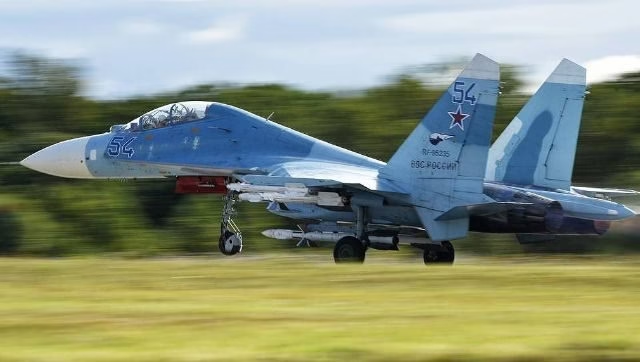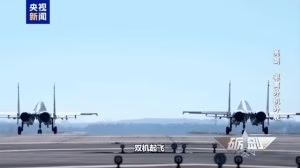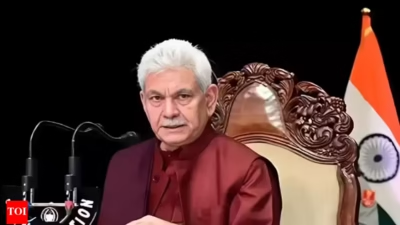Russian Su-27 crash hits Nizhny Novgorod, pilots eject safely


Summary
– A Russian Su-27 jet crashed in Nizhny Novgorod on July 1, 2025.
– Both pilots ejected, but one remains missing.
– The incident raises concerns about Russia’s aging air force.
– Global military tensions could be impacted by this event.
– Details unfold as search efforts continue.
A Russian Su-27 fighter jet crashed Tuesday in the Nizhny Novgorod Oblast, approximately 250 miles east of Moscow, marking a significant incident for the country’s air force. The crash occurred around 1:42 p.m. local time, according to reports from the Russian media outlet Mash, with both pilots managing to eject from the aircraft before it hit the ground near the town of Kulebaki.
One pilot has been located and is reported to be unharmed, while search efforts continue for the second, who remains missing. The event, which took place during what is believed to be a training mission, has sparked concerns about the operational status of Russia’s aging fleet and its military capabilities amid ongoing geopolitical tensions, particularly in the context of the conflict in Ukraine.
Details about the cause of the crash remain scarce, with no official statement yet released by the Russian Ministry of Defense. Local reports indicate the pilots steered the jet away from populated areas, and rescuers are currently combing the forested region southeast of the village of Veletma in the Vyksa district.
There are no confirmed reports of casualties or damage on the ground, though the lack of transparency from authorities has fueled speculation about the incident’s implications. This event underscores the challenges facing Russia’s air force as it balances operational demands with the maintenance of decades-old aircraft.
What we know so far
The crash site lies close to the Savasleyka military airfield, a key base for Russian air operations, though it’s unclear if the jet was returning from or preparing for a mission there. Mash, a Russian news outlet known for its ties to law enforcement sources, reported that the aircraft went down in a remote area, avoiding residential zones due to the pilots’ actions.
The Su-27, a twin-seat variant likely used for training, was not carrying live ammunition, suggesting the flight was part of a routine exercise. Rescue teams, including local emergency services, have been deployed to locate the missing pilot, with operations ongoing as of late afternoon.
Russian authorities have yet to provide a detailed account, leaving many questions unanswered. The absence of immediate footage or official updates has led to a reliance on preliminary reports from media and social platforms. The incident’s proximity to a military installation raises the possibility of technical issues or human error, though no evidence supports either theory at this stage. As investigations proceed, the focus will likely shift to the condition of the aircraft and the training protocols in place.
The Su-27: a veteran of the skies
The Su-27, developed by the Soviet Union in the 1970s and introduced in 1985, is a heavyweight in the world of air superiority fighters. Designed to counter American aircraft like the F-15 Eagle, this jet boasts a top speed of Mach 2.35, or roughly 1,500 miles per hour, and a combat radius of about 900 miles.
Its distinctive aerodynamic design, featuring a blended wing-body configuration, allows for exceptional maneuverability, making it a favorite in airshows and dogfights. Equipped with a Phazotron N001 Myech radar and capable of carrying a mix of air-to-air missiles such as the R-27 and R-73, the Su-27 was built to dominate the skies.
The twin-seat Su-27UB variant, likely involved in this crash, serves as a trainer and combat aircraft, accommodating an instructor alongside the pilot. This model retains much of the original’s firepower but prioritizes pilot training, a critical function given the jet’s complexity.
Compared to newer Russian platforms like the Su-35, which features advanced avionics and thrust-vectoring engines, or the stealth-focused Su-57, the Su-27 relies on proven, if dated, technology. In the global arena, it stands alongside the U.S. F-16 Fighting Falcon and France’s Dassault Rafale, though its lack of modern upgrades places it at a disadvantage against these contemporaries.
The pilots behind the controls
Operating a Su-27 requires extensive training, particularly for the UB variant used in instructional flights. Russia’s air force maintains a rigorous program, with pilots undergoing hundreds of hours in simulators before taking to the skies. These sessions focus on high-G maneuvers and emergency procedures, including ejection drills, which proved vital in this incident. The dual-seat design allows experienced instructors to guide trainees, often young officers with limited combat exposure, through complex scenarios.
The demands on Russia’s pilots have intensified with ongoing conflicts, potentially leading to fatigue or errors. Historical data from the Russian military suggests that human factors contribute to a notable percentage of aviation incidents, though specific figures for 2025 are pending.
Pilots flying the Su-27UB typically have at least five years of service, with expertise in aerobatics and survival techniques. Without official confirmation of the crew’s identities, their experience level remains speculative, but their successful ejections highlight the effectiveness of their training, as noted in general overviews from the International Institute for Strategic Studies.
A pattern of incidents
Aircraft crashes are not uncommon in military aviation, and Russia has faced several in recent years. In 2024, a Su-34 fighter-bomber went down in Voronezh Oblast due to engine failure, while a Su-30 crashed in Rostov region during a training exercise, both resulting in pilot ejections. These incidents point to recurring issues, including mechanical wear and maintenance challenges. Western air forces, such as the U.S. Air Force, report similar events, with an F-16 crash in Nevada last year attributed to pilot error, illustrating a global trend.
Russia’s fleet, heavily reliant on Soviet-era designs, faces additional strain from economic sanctions imposed since 2014, particularly after the Ukraine conflict escalated. These restrictions limit access to spare parts and advanced technology, potentially compromising safety standards. The crash near Kulebaki adds to this narrative, though without an official investigation, the root cause remains unclear. Historical context from the Stockholm International Peace Research Institute highlights how sanctions have impacted military readiness across multiple domains.
Media and public response
The crash has sparked varied reactions across Russian media and online platforms. State-run channels like Rossiya 1 have yet to feature the incident prominently, while independent outlets such as Novaya Gazeta have raised questions about the lack of official statements from the Ministry of Defense. Telegram channels, including those linked to military sources, have posted updates with a mix of concern and skepticism, with some users questioning the aircraft’s condition and others downplaying the event’s significance.
Social media posts on platforms like X reflect a range of sentiments, from tension over the missing pilot to attempts to dismiss the crash as routine. The absence of video evidence and limited details about the second pilot’s status have fueled speculation about a controlled narrative, a tactic observed in past incidents like the 2018 Su-57 prototype crash. Foreign analysts, including those from the U.S.-based Center for Strategic and International Studies, have noted Russia’s pattern of restricting information during military setbacks, though no specific comments on this event are available yet at www.csis.org.
Geopolitical and military implications
This incident occurs against the backdrop of Russia’s military engagement in Ukraine, where its air force plays a crucial role. The loss of a Su-27, even in a training context, could strain an already stretched fleet, with reports indicating heavy use of aircraft in eastern Ukraine.
The conflict has seen increased drone and missile activity, putting pressure on Russia’s aviation resources. Analysts suggest that such losses might prompt a reassessment of operational priorities, especially as the country pushes to modernize with jets like the Su-57.
The crash raises doubts about the reliability of Russia’s military hardware, a concern amplified by sanctions that hinder access to Western components. Neighboring countries, including Ukraine, which operates a small number of Su-27s inherited from the Soviet era, may view this as a signal of broader vulnerabilities.
Tactics and operations under scrutiny
The Su-27’s role in training missions involves simulating combat scenarios, typically without live ordnance, as confirmed by Mash’s reporting. These flights test pilots’ skills in navigation, formation flying, and emergency responses, relying on the jet’s advanced sensors like the infrared search and track system. The aircraft’s design emphasizes air superiority, a doctrine central to Russia’s military strategy, which prioritizes controlling the skies over contested zones.
The decision to steer the jet away from populated areas suggests adherence to safety protocols, but the crash’s cause—whether mechanical, environmental, or human-related—remains under investigation. Historical operations, such as those during the 2008 Georgia conflict, showcased the Su-27’s effectiveness, yet maintenance issues have since emerged as a recurring challenge, according to the U.S. Air Force’s public data.
Broader technological and strategic trends
Russia’s air force operates in a competitive global landscape, where the U.S. fields the F-35 Lightning II and China develops the J-20 stealth fighter. These platforms incorporate cutting-edge stealth and electronic warfare capabilities, outpacing the Su-27’s analog roots. Sanctions have forced Russia to seek alternatives, partnering with nations like India, which uses a licensed Su-30 variant, though supply chain disruptions pose ongoing risks.
The incident highlights the challenges of sustaining a Cold War-era fleet. Countries like Ukraine, which lost several Su-27s to Russian strikes, and India, a major Su-30 operator, may reconsider their reliance on Russian technology.
What lies ahead for Russia’s Air Force
As rescue efforts continue, attention will turn to the investigation’s findings. Experts anticipate a focus on the Su-27’s maintenance history and the training mission’s parameters. The Russian government may respond with enhanced safety measures or accelerated modernization efforts, though funding constraints could limit progress. The outcome could influence international perceptions of Russia’s military prowess, particularly among NATO allies monitoring the situation.
Long-term, the crash may prompt a shift toward newer aircraft like the Su-57, though production delays persist. The incident’s impact on morale and operational readiness will depend on the investigation’s transparency, a factor that has historically been lacking in similar cases.
Looking forward: a call for clarity
The crash of a Su-27 in Nizhny Novgorod Oblast serves as a stark reminder of the challenges facing Russia’s air force in an era of technological evolution and geopolitical strain. With one pilot safe and another still missing, the immediate focus remains on the human element, while broader questions linger about the fleet’s future.
As details emerge, the need for open disclosure will be critical to understanding whether this is an isolated mishap or a symptom of deeper systemic issues. Will Russia address these concerns, or will the narrative remain shrouded in silence? Only time will tell.
***
Follow us everywhere and at any time. BulgarianMilitary.com has responsive design and you can open the page from any computer, mobile devices or web browsers. For more up-to-date news, follow our Google News, YouTube, Reddit, LinkedIn, and Twitter pages. Our standards: Manifesto & ethical principles.
How we confirmed this story:
- BulgarianMilitary.com cross-references open-source intelligence, including battlefield maps and geolocated footage, to confirm military movements and resource claims. We analyze official statements, expert insights from defense analysts, and economic data to ensure accuracy.
- Social media posts are scrutinized and validated against primary sources, such as government reports and on-the-ground accounts. Our rigorous process guarantees reliable, fact-based reporting.














